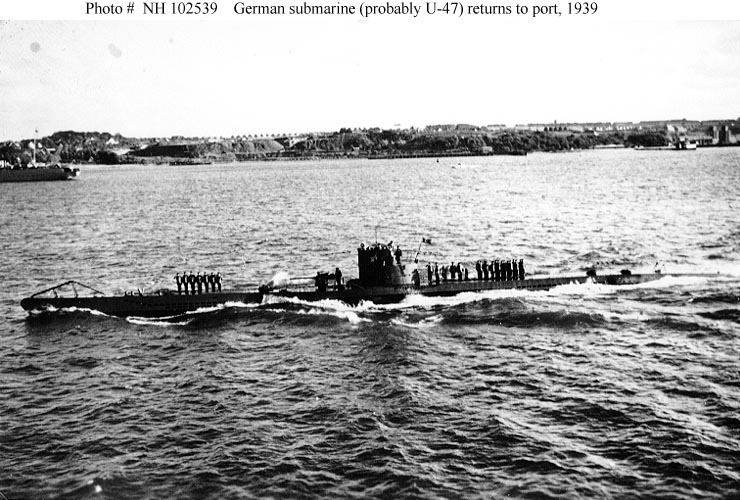| Sinking Royal Oak
By David Lippman
October 2012
Having penetrated the British fleet base at Scapa Flow, in the early hours of October 14th 1939 Günther Prien and his submarine U-47 have scored only one hit on the battleship Royal Oak, causing minor damage the crew attributed to an accident.
Finally, U-47 turns round again and fires torpedoes from bow tubes 1, 2, and 4. All three torpedoes whack home against the battleship’s starboard side, blasting a huge hole in the engine room and two more amidships, setting off a raging fire in Royal Oak’s magazine, and hurling debris into the sky. The battleship shakes violently. The lights and public address system go out, and flames spread rapidly.

Royal Oak at Malta, 1938.
Commander C.H.A. Harper, the ship’s executive officer, recalls, “Then, just 13 minutes after the first explosion, came three more sickening, shattering thuds abaft us on the starboard side. Each explosion rocked the ship alarmingly, all lights went out and she at once took a list of about 25 degrees. There was no doubt in my mind what had happened this time, nor what was going to happen. How on earth had a submarine got through the defenses?”
Harper is aware, as his ship begins to roll over, that there are a large number of portholes open, fitted with “light-excluding ventilators,” to bring fresh air into the crowded mess-decks. Every one of them on the starboard side is now flooding with water and impossible to close.
Stoker Herbert Johnston gets up on deck, and everyone there agrees there must have been an explosion in the CO2 compartment, or the inflammable store. Johnston goes to get his gas mask, just in case, and goes back to restarting his refrigerating machinery, when the second and third explosions hit. “The ship immediately began to list to starboard and there was a foul smell of cordite. I decided I had better go up on the upper deck in case there was something seriously wrong.”
When Johnston reaches the ladder there is a big crowd around it. As he puts his hand on the hatch-combing, the lights go out and he can see the sky.
“When I got on deck I didn’t know what to do. After a few minutes I saw Lt. Slater go over the 4-inch gun shield and slide down the into the picket boat, so I went over the guard-rail and followed him down. The ship was well heeled-over then, the lower boom was up at a very high angle, and that had pulled the picket boat in close to the ship’s side.”
He slithers down into the boat and it gradually fills up. “After a few moments there was another series of explosions, at an even speed, that seemed to from forward to right aft. Meantime the ship was heeling over very rapidly and the picket boat was getting fuller and fuller of people.”
Thirteen minutes after the last hit, the old battleship rolls over and sinks. She takes 833 of her 1,200-man crew with her.
“In the picket boat,” Johnston says, “somebody started up a song, but it fizzled out before the end of the first verse. About that time the picket boat became so over-crowded and top-heavy, that it capsized.” Johnston and his shipmates are thrown into the water. Fortunately, Royal Oak’s attendant drifter, Daisy II, is moving about, picking up survivors. He swims toward her, getting rid of his boiler suit, but keeping his purse with his £3. He swims near to the Daisy II, and the drifter ultimately takes him on board.
“I recall only a frantic rush and a scramble up on the ship’s side as she spun round in the act of sinking, and, when she sank under me, how cold the water was on my feet as my short sea boots fell off. Then in the darkness, an intense feeling of loneliness seized me and I remember little else until I found myself sharing a raft with several others – all of us soaked in a foul-smelling, slippery, chilly mixture of sea water and fuel oil,” says Cdr. Harper.
Certain now that he has been seen, at 1:28 a.m. Prien turns his submarine about and heads at high speed for the Kirk Sound escape route. Actually, nobody’s seen him at all. The British are either rescuing Royal Oak crewmen or frozen in shock at the spectacle. Prien could have unloaded his five remaining torpedoes on “Repulse” without fear of enemy counterattack. But he’s done his job.
On Daisy II, there is a huge line for the bathroom, because all the Royal Oak sailors are covered in fuel oil. The tiny drifter jams 386 men on board a vessel 17 feet wide and a little over 100 feet long. The men are squeezed into the boiler room, the engine room, the holds and the cabins; they stand on engine room casings and cling to the rigging. Those too injured or exhausted to move lie on deck. The skipper of Daisy II, John Gatt, though a civilian like his crew, is awarded the Distinguished Service Cross for his rescue work.

The victorious U47 returns to Kiel.
Two and a half hours after sinking Royal Oak, Prien sails out of the west end of Kirk Sound and begins the exit, going south of the blockships. “Things are again difficult,” he logs. Making constant changes in speed and helm, he skirts past the blockships “with nothing to spare.” Then he bends on flank speed to Holm Sound.
At 2:15 a.m., Prien logs, “”We are once more outside,” and adds it is “a pity only one ship was destroyed.”
The British admit to the sinking of Royal Oak with great loss of life that day. Home Fleet commander Adm. Forbes immediately bars all Royal Navy ships from entering Scapa Flow until the defenses are improved.
Berlin announces the sinking as well, but withholds a public celebration until a radio report from Prien. Joseph Goebbels crows into his diary. “This is a success that we can show off to the world, and the kind of blow that the English cannot ignore. . . . the neutral press is starting to scream for peace. London is in an unenviable position, and the serious loss of the battleship on top of everything else. Churchill is clearly beginning to waver. Now we must strike home ruthlessly. And we shall be careful to do so. Our whole cutting-edge is directed against England now.”
On the 16th, U-47 surfaces to break radio silence and officially report to Berlin that Royal Oak has been sunk and Repulse damaged. Germany is ecstatic. The German Navy command gloats, “A glorious success.” It logs in its war diary that the sinking of Royal Oak and damaging of Repulse are “hard blows” that “greatly impair British prestige,” and enhance respect for the German Navy. The feat also “awakens affection” for the “young submarine arm” that has amply demonstrated its “outstanding operational efficiency.”
 On the U-boat, first watch officer Engelbert Endrass paints a massive bull charging with lowered horns and steaming nostrils on both sides of U-47’s conning tower. Prien is now “The Bull of Scapa Flow.” The symbol becomes the official logo of the entire Wegener Flotilla. On the U-boat, first watch officer Engelbert Endrass paints a massive bull charging with lowered horns and steaming nostrils on both sides of U-47’s conning tower. Prien is now “The Bull of Scapa Flow.” The symbol becomes the official logo of the entire Wegener Flotilla.
U-47 arrives home at Wilhelmshaven the next day with Dönitz and fleet commander Adm. Erich Raeder both standing on the pier to greet Prien and his merry men. When the lines are secured, the two admirals cross the bow and shake hands with the entire crew. Everyone aboard gets an Iron Cross, Second Class, while Prien himself gets the Iron Cross First Class. Then the big news: Hitler is sending his personal Condor aircraft to fly the crew to Berlin.
Royal Oak’s hulk is declared a War Grave, and the ship is protected, with buoys above her, warning that diving on the wreck is illegal. A White Ensign “flies” from her outer propeller shaft. Like another war grave ship, the USS Arizona, the hull leaks oil to this day and the discoloration can be seen on the waters of Scapa Flow.
Some salvage is done – her deadly ammunition, for example, and her ship’s bell, which now sits in a place of honor at St. Magnus Cathedral in Kirkwall, overlooking Scapa Flow.
David H. Lippman, an award-winning journalist and graduate of the new School for Social Research, has written many magazine articles about World War II. He maintains the World War II Plus 55 website and currently works as a public information officer for the city of Newark, N.J. We're always pleased to add his work to our Daily Content.
|


